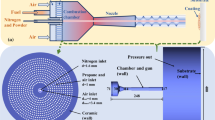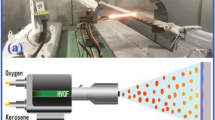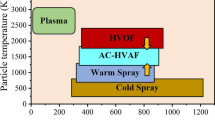Abstract
Understanding formation and evolution of oxidation in the thermal spray process is of significance since it affects greatly the corrosion resistance of coatings. In this work, the growth of oxide layers on in-flight Fe-based amorphous powders in high velocity air fuel (HVAF) thermal spray process was studied in detail by means of numerical and experimental methods. An oxidation model, based on the Lagrangian manner, was used to track the Fe-based amorphous particles. The simulation results showed that the increment of oxide layer thickness was codetermined by oxygen partial pressure of in-flight particles and particle temperature. It occurred primarily in the combustion chamber and barrel rather than the outflow field stage after flame flow. Furthermore, the relationship between in-flight particle oxidation and spray parameters was predicted by simulation. The optimal combustion chamber pressure is 90 psi and the optimal oxygen fuel ratio is 2.95. These were verified by the microstructural feature of in-flight collected particles, and low-oxidation Fe-based amorphous coating was obtained by HVAF utilizing the predicted spray parameters. This work offers us beneficial guidance of fabricating low-defect amorphous metallic coating.














Similar content being viewed by others
Data Availability
The raw/processed data required to reproduce these findings are available from the corresponding author upon request.
Abbreviations
- \(A_{0}\) :
-
Model constant \(\left( {{\text{A}} \cdot {\text{s}}^{ - 1} } \right)\)
- \(C_{{\text{D}}}\) :
-
Drag coefficient
- \(C_{{\text{p}}}\) :
-
Specific heat capacity \(\left( {{\text{J}} \cdot {\text{kg}}^{ - 1} \cdot {\text{K}}^{ - 1} } \right)\)
- \(d_{{\text{p}}}\) :
-
Diameter of particle (m)
- E :
-
Enthalpy \(\left( {{\text{J}} \cdot {\text{kg}}^{ - 1} } \right)\)
- f :
-
Solid fraction
- g :
-
Gravitational acceleration \(\left( {{\text{m}} \cdot {\text{s}}^{ - 1} } \right)\)
- h :
-
Convective heat transfer coefficient \(\left( {{\text{W}} \cdot {\text{m}}^{ - 2} \cdot {\text{K}}^{ - 1} } \right)\)
- H :
-
Total heat transfer coefficient \(\left( {{\text{W}} \cdot {\text{m}}^{ - 2} \cdot {\text{K}}^{ - 1} } \right)\)
- \(H_{{{\text{ox}}}}\) :
-
Heat of oxidation \(\left( {{\text{J}} \cdot {\text{kg}}^{ - 1} } \right)\)
- \(H_{{{\text{sf}}}}\) :
-
Latent heat \(\left( {{\text{J}} \cdot {\text{kg}}^{ - 1} } \right)\)
- k :
-
Thermal conductivity \(\left( {{\text{W}} \cdot {\text{m}}^{ - 1} \cdot {\text{K}}^{ - 1} } \right)\)
- \(k_{{\text{b}}}\) :
-
Boltzman constant
- \(k_{{\text{g}}}\) :
-
Thermal conductivity of gas \(\left( {{\text{W}} \cdot {\text{m}}^{ - 1} \cdot {\text{K}}^{ - 1} } \right)\)
- \(k_{{{\text{ox}}}}\) :
-
Thermal conductivity of oxide layer \(\left( {{\text{W}} \cdot {\text{m}}^{ - 1} \cdot {\text{K}}^{ - 1} } \right)\)
- \(k_{{\text{s}}}\) :
-
Thermal conductivity of particle \(\left( {{\text{W}} \cdot {\text{m}}^{ - 1} \cdot {\text{K}}^{ - 1} } \right)\)
- \(k_{0}\) :
-
Model constant \(\left( {{\text{eV}} \cdot {\text{Torr}}^{ - 0.5} } \right)\)
- \({\text{N}}_{{\text{u}}}\) :
-
Nusselt number
- p :
-
Pressure (Pa)
- Pr:
-
Prandtl number
- \(P_{{{\text{O}}_{2} }}\) :
-
Partial pressure of O2 (Torr)
- \(q_{{\text{h}}}\) :
-
External heat source
- Q :
-
Model constant (eV)
- r :
-
Spherical coordinate
- Re:
-
Reynolds number
- s :
-
Surface area of a sphere having the same volume as the particle
- S :
-
Actual surface area of the particle
- \(\Delta t\) :
-
Time step (s)
- T :
-
Temperature (K)
- \(T_{{\text{g}}}\) :
-
Gas temperature (K)
- \(T_{{\text{k}}}\) :
-
Melting temperature of the primary element (K)
- \(T_{{\text{L}}}\) :
-
Liquidus temperature (K)
- \(T_{{\text{s}}}\) :
-
Solidus temperature (K)
- u :
-
Velocity
- \(\Delta x\) :
-
Gird nodes distance (m)
- \(\alpha\) :
-
Thermal diffusivity \(\left( {{\text{m}}^{2} \cdot {\text{s}}^{ - 1} } \right)\)
- \(\beta\) :
-
Ratio between solid and liquid concentration
- Г :
-
Total energy (internal + kinetic)
- \(\delta\) :
-
Oxide layer thickness (A)
- \(\mu\) :
-
Coefficient of viscosity \(\left( {{\text{N}} \cdot {\text{m}}^{ - 2} {\text{s}}^{ - 1} } \right)\)
- \(\rho\) :
-
Density \(\left( {{\text{kg}} \cdot {\text{m}}^{ - 1} } \right)\)
- \(\tau\) :
-
Deviatoric stress tensor
- \(\psi \left( T \right)\) :
-
Correction function
- g:
-
Gas
- i, j, l:
-
Co-ordinate indices
- ox:
-
Oxide
- p:
-
Particle
- R:
-
Particle radius
References
J. Farmer, J.-S. Choi, C. Saw, J. Haslam, D. Day, P. Hailey, T. Lian, R. Rebak, J. Perepezko, J. Payer, D. Branagan, B. Beardsley, A. D’amato, and L. Aprigliano, Iron-Based Amorphous Metals: High-Performance Corrosion-Resistant Material Development, Metall. Mater. Trans. A, 2009, 40, p 1289-1305.
H.S. Ni, X.H. Liu, X.C. Chang, W.L. Hou, W. Liu, and J.Q. Wang, High Performance Amorphous Steel Coating Prepared by HVOF Thermal Spraying, J. Alloys Compd., 2009, 467, p 163-167.
G. Bolelli, B. Bonferroni, J. Laurila, L. Lusvarghi, A. Milanti, K. Niemi, and P. Vuoristo, Micromechanical Properties and Sliding Wear Behaviour of HVOF-Sprayed Fe-Based Alloy Coatings, Wear, 2012, 276-277, p 29-47.
H. Zhang, Y. Hu, G. Hou, Y. An, and G. Liu, The Effect of High-Velocity Oxy-Fuel Spraying Parameters on Microstructure, Corrosion and Wear Resistance of Fe-based Metallic Glass Coatings, J. Noncryst. Solids, 2014, 406, p 37-44.
G.Y. Koga, R. Schulz, S. Savoie, A.R.C. Nascimento, Y. Drolet, C. Bolfarini, C.S. Kiminami, and W.J. Botta, Microstructure and Wear Behavior of Fe-based Amorphous HVOF Coatings Produced from Commercial Precursors, Surf. Coat. Technol., 2017, 309, p 938-944.
C. Zhang, K.C. Chan, Y. Wu, and L. Liu, Pitting Initiation in Fe-based Amorphous Coatings, Acta Mater., 2012, 60, p 4152-4159.
E. Sadeghimeresht, N. Markocsan, and P. Nylén, Microstructural Characteristics and Corrosion Behavior of HVAF- and HVOF-Sprayed Fe-based Coatings, Surf. Coat. Technol., 2017, 318, p 365-373.
J. Wu, S.D. Zhang, W.H. Sun, and J.Q. Wang, Influence of Oxidation Related Structural Defects on Localized Corrosion in HVAF-Sprayed Fe-Based Metallic Coatings, Surf. Coat. Technol., 2018, 335, p 205-218.
R.A. Neiser, M.F. Smith, and R.C. Dykhuizen, Oxidation in Wire HVOF-Sprayed Steel, J. Therm. Spray Technol., 1998, 7, p 537-545.
S. Rahmati, R.G.A. Veiga, A. Zúñiga, and B. Jodoin, A Numerical Approach to Study the Oxide Layer Effect on Adhesion in Cold Spray, J. Therm. Spray Technol., 2021, 30, p 1777-1791.
P. Khamsepour, C. Moreau, and A. Dolatabadi, Effect of Particle and Substrate Pre-heating on the Oxide Layer and Material Jet Formation in Solid-State Spray Deposition: A Numerical Study, J. Therm. Spray Technol., 2022, 32, p 1153-1166.
V.V. Sobolev and J.M. Guilemany, Effect of Oxidation on Droplet Flattening and Splat-Substrate Interaction in Thermal Spraying, J. Therm. Spray Technol., 1999, 8, p 523-530.
K. Dobler, H. Kreye, and R. Schwetzke, Oxidation of Stainless Steel in the High Velocity Oxy-Fuel Process, J. Therm. Spray Technol., 2000, 9, p 407-413.
S. Deshpande, S. Sampath, and H. Zhang, Mechanisms of Oxidation and its Role in Microstructural Evolution of Metallic Thermal Spray Coatings-Case Study for Ni-Al, Surf. Coat. Technol., 2006, 200, p 5395-5406.
V.V. Sobolev and J.M. Guilemany, Oxidation of Coatings in Thermal Spraying, Mater. Lett., 1998, 37, p 231-235.
D. Seo, K. Ogawa, T. Shoji, and S. Murata, Effect of Particle Size Distribution on Isothermal Oxidation Characteristics of Plasma Sprayed CoNi- and CoCrAlY Coatings, J. Therm. Spray Technol., 2007, 16, p 954-966.
C.J. Li, H.T. Wang, Q. Zhang, G.J. Yang, W.Y. Li, and H. Liao, Influence of Spray Materials and Their Surface Oxidation on the Critical Velocity in Cold Spraying, J. Therm. Spray Technol., 2010, 19, p 95-101.
A.A. Syed, A. Denoirjean, P. Fauchais, and J.C. Labbe, On the Oxidation of Stainless Steel Particles in the Plasma Jet, Surf. Coat. Technol., 2006, 200, p 4368-4382.
P. Fauchais, M. Fukumoto, A. Vardelle, and M. Vardelle, Knowledge Concerning Splat Formation: An Invited Review, J. Therm. Spray Technol., 2004, 13, p 337-360.
G.-R. Li, B. Cheng, G.-J. Yang, and C.-X. Li, Strain-Induced Stiffness-Dependent Structural Changes and the Associated Failure Mechanism in TBCs, J. Eur. Ceram. Soc., 2017, 37, p 3609-3621.
A.A. Syed, A. Denoirjean, P. Denoirjean, J.C. Labbe, and P. Fauchais, In-flight Oxidation of Stainless Steel Particles in Plasma Spraying, J. Therm. Spray Technol., 2005, 14, p 117-124.
N. Zeoli, S. Gu, and S. Kamnis, Numerical Simulation of In-flight Particle Oxidation During Thermal Spraying, Comput. Chem. Eng., 2008, 32, p 1661-1668.
H. Jafari, S. Emami, and Y. Mahmoudi, Numerical Investigation of Dual-Stage High Velocity Oxy-Fuel (HVOF) Thermal Spray Process: A Study on Nozzle Geometrical Parameters, Appl. Therm. Eng., 2017, 111, p 745-758.
M.N. Khan and T. Shamim, Investigation of a Dual-Stage High Velocity Oxygen Fuel Thermal Spray System, Appl. Energy, 2014, 130, p 853-862.
S. Kamnis and S. Gu, Numerical Modelling of Propane Combustion in a High Velocity Oxygen-Fuel Thermal Spray Gun, Chem. Eng. Process., 2006, 45, p 246-253.
D. Cheng, Q. Xu, G. Tapaga, and E.J. Lavernia, A Numerical Study of High-Velocity Oxygen Fuel Thermal Spraying Process. Part I: Gas Phase Dynamics, Metall. Mater. Trans. A, 2001, 32, p 1609-1620.
S. Gordon and B.J. McBride, Computer Program for Calculation of Complex Chemical Equilibrium Compositions and Applications. Part 1: Analysis, NASA Reference Publication, Cleveland, OH, USA, 1994, p 4561
A. Dolatabadi, J. Mostaghimi, and V. Pershin, Effect of a Cylindrical Shroud on Particle Conditions in High Velocity Oxy-Fuel Spray Process, Sci. Technol. Adv. Mater., 2002, 3, p 245-255.
H. Tabbara and S. Gu, Computational Simulation of Liquid-Fuelled HVOF Thermal Spraying, Surf. Coat. Technol., 2009, 204, p 676-684.
V.V. Sobolev and J.M. Guilemany, Dynamic Processes During High Velocity Oxyfuel Spraying, Int. Mater. Rev., 1996, 41, p 13-32.
W.E. Ranz and W.R. Marshall, Evaporation from Drops, Part I, Chem. Eng. Prog., 1952, 48, p 141-146.
S.L. Dai, J.P. Delplanque, and E.J. Lavernia, Microstructural Characteristics of 5083 Al Alloys Processed by Reactive Spray Deposition for Net-Shape Manufacturing, Metall. Mater. Trans. A, 1998, 29, p 2597-2611.
A.M. Ahmed, R.H. Rangel, V.V. Sobolev, and J.M. Guilemany, In-flight Oxidation of Composite Powder Particles During Thermal Spraying, Int. J. Heat Mass Transf., 2001, 44, p 4667-4677.
H. Tabbara and S. Gu, A Study of Liquid Droplet Disintegration for the Development of Nanostructured Coatings, AIChE J., 2012, 58, p 3533-3544.
J. Pan, S. Hu, L. Yang, K. Ding, and B. Ma, Numerical Analysis of Flame and Particle Behavior in an HVOF Thermal Spray Process, Mater. Des., 2016, 96, p 370-376.
M. Jadidi, S. Moghtadernejad, and A. Dolatabadi, Numerical Modeling of Suspension HVOF Spray, J. Therm. Spray Technol., 2015, 25, p 451-464.
H.-R. Jiang, M.-L. Li, X.-S. Wei, T.-C. Ma, Y. Dong, C.-X. Ying, Z.-Y. Liao, and J. Shen, Numerical Investigation of In-flight Behavior of Fe-based Amorphous Alloy Particles in AC-HVAF Thermal Spray Process, J. Therm. Spray Technol., 2019, 28, p 1146-1159.
H.F. Voggenreiter, H. Huber, S. Beyer, and H.J. Spies, Influence of Particle Velocity and Molten Phase on the Chemical and Mechanical Properties of HVOF-Sprayed Structural Coatings of Alloy 316L, Advantages Thermal Spray Science Technology. C.C. Berndt, S. Sampath Ed., ASM International, Materials Park, 1995, p 303-308
H.F. Voggenreiter, H. Huber, and H.J. Spies, HVOF Sprayed Alloy In718—The Influence of Process Parameters on the Microstructure and Mechanical Properties, Forum for Scientific and Technological Advances. C.C. Berndt Ed., ASM International, Materials Park, OH, 1997
C. Hackett and G. Settles, The High-Velocity Oxy-Fuel (HVOF) Thermal Spray-Materials Processing from A Gas Dynamics Perspective, 26th AIAA Fluid Dynamics Conference. San Diego, CA, USA, 1995
J.A. Browning, Highly Concentrated Supersonic Liquified Material Flame Spray Method and Apparatus, US Patent, Alexandria Virginia, 1985.
H. Herman, Advances in Thermal-Spray Technology, Adv. Mater. Process., 1990, 137, p 41-45.
P. Kofstad and C.A. Steidel, High Temperature Oxidation of Metals, J. Electrochem. Soc., 1967, 114, p 167C.
T.C. Hanson and G.S. Settles, Particle Temperature and Velocity Effects on the Porosity and Oxidation of an HVOF Corrosion-Control Coating, J. Therm. Spray Technol., 2003, 12, p 403-415.
Acknowledgments
This work was supported by the National Natural Science Foundation of China (Nos. U1908219, 52171163), the Key Research Program of the Chinese Academy of Sciences (No. ZDRW-CN-2021-2-2), Natural Science Foundation of Liaoning Province (No. 2022-MS-364), Educational Commission of Liaoning Province of China (No. L2020021), Fushun Revitalization Talents Program (No. FSYC202107011).
Author information
Authors and Affiliations
Corresponding author
Additional information
Publisher's Note
Springer Nature remains neutral with regard to jurisdictional claims in published maps and institutional affiliations.
Rights and permissions
Springer Nature or its licensor (e.g. a society or other partner) holds exclusive rights to this article under a publishing agreement with the author(s) or other rightsholder(s); author self-archiving of the accepted manuscript version of this article is solely governed by the terms of such publishing agreement and applicable law.
About this article
Cite this article
Wu, NC., Yang, F., Sun, WH. et al. In-Flight Oxidation of Fe-Based Amorphous Particle During HVAF Spraying: Numerical Simulation and Experiment. J Therm Spray Tech 32, 2187–2201 (2023). https://doi.org/10.1007/s11666-023-01623-0
Received:
Revised:
Accepted:
Published:
Issue Date:
DOI: https://doi.org/10.1007/s11666-023-01623-0




